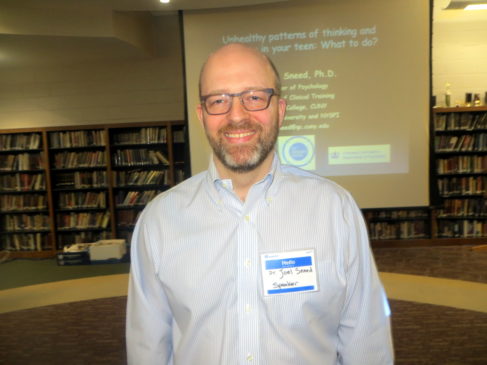
[slideshow_deploy id=’899′]BY HILLARY VIDERS
SPECIAL TO NORTHERN VALLEY PRESS
CRESSKILL, NEW JERSEY —— Depression is one of the most common mental disorders in the United States. Current research suggests that depression is caused by a combination of genetic, biological, environmental and psychological factors.
Depression can happen at any age, but it often begins in adolescence, according to the 2016 National Survey on Drug Use and Health. Major clinical depression effects 20 percent of all adolescents, with girls experiencing depression three times as much as boys, according to the survey.

Depression increases a teen’s risk for attempting suicide by 12 times, according to the national survey, and 30 percent of teens with depression also develop a substance abuse problem. The 2016 National Survey on Drug Use and Health further states that depressed teens usually have a smaller social circle and take advantage of fewer career and educational opportunities. Depressed teens are also more likely to have trouble at school and in jobs, and to struggle with relationships.
Symptoms of depression in teens may manifest themselves in different ways than in adults due to the different social and developmental challenges facing teens. The survey states that these may include identity development, peer pressure, sports, changing hormone levels and developing bodies.
Depression is associated with high levels of stress, anxiety, and it can also affect a teen’s personal life, school life, work life, social life and family life. This can lead to social isolation and other problems, and in the worst possible scenarios, suicide.
Cresskill HSA addresses the problem
To address this critical issue, the Cresskill Home and School Association (HSA) hosted a presentation about depression, a subject that for many parents hits close to home. It was part of a series of HSA speaker events that is held every year.
On Feb. 7, a lecture titled “Unhealthy Patterns of Thinking, Functioning and Behaving in Your Teenager and What You Can Do” was given by Dr. Joel Sneed, a professor of psychology at Queens College of the City University of New York and adjunct assistant professor of medical psychology (in psychiatry) at Columbia University and the New York State Psychiatric Institute.
Sneed has published more than 50 peer-reviewed journal articles and his research program in depression and cognitive functioning is funded by the National Institute of Mental Health. In addition to his research, Sneed has been a clinician in private practice for more than 10 years. He is a Columbia University trained psychoanalyst and has also been trained in dialectical behavior therapy. His clinical work focuses primarily on the treatment of depression, anxiety, eating disorders and personality disorders.
Despite a rainy downpour, over 50 parents and guests went to the Cresskill Middle School/ High School library for the presentation.
Using a PowerPoint presentation, Sneed spoke about the challenges that adolescents face, including developing an identity. While most teenagers navigate this very challenging time of life, some do not, and develop depression, anxiety, eating disorders and even personality disorders (among others).
During a 40-minute presentation and a question and answer session, Sneed explored intervention and elements of treatment, such as a cognitive behavior model, that he has found to be particularly useful, and he discussed the effectiveness of psychotherapy for these disorders.
Sneed began by enumerating the classic signs of major depressive disorder, a very common dysfunction:
• Persistent sad, anxious or “empty” mood;
• Feelings of hopelessness, or pessimism;
• Feelings of worthlessness;
• Loss of interest or pleasure in hobbies and activities;
• Decreased energy or fatigue;
• Sleeping too little or sleeping too much;
• Appetite and/or weight changes;
• Headaches;
• Thoughts of death or suicide, or suicide attempts.
[slideshow_deploy id=’899′]
Sneed elicited nods and laughs when he drew a parallel between a typical emotionally immature teenager and a NASCAR racing car: “They both have a large body and high octane fuel, but a really bad driver.”
He explained that a large part of his work is about teenage identity and its components, including separating from one’s parents, social development, developing friends and striving for independence. When a teenager’s identity is disrupted, it can lead to an identity crisis and an anxiety disorder. A longitudinal study has shown that identity development is so important that identity wellbeing in adolescence can predict wellbeing at age 54.
Sneed also provided a framework for understanding cognitive distortions that connect thoughts to feelings and behaviors. He emphasized that most cases of depression involve an anxiety disorder (such as panic anxiety, chronic worry, social anxiety, e.g.), and illustrated techniques that he uses with private patients who are suffering from anxiety and depression to sensitize them to their thoughts and teach them to use adaptive responses.
A key cognitive behavior technique that Sneed recommends is having the person keep a journal. To do this, the person notes each thought, or “cognitive distortion” or overgeneralization, that leads to depression, (such as, “I missed 10 questions on my test, so I’m an idiot, I’m a failure”), as well as the feelings that it engenders (sadness, anxiety, frustration), followed by the behavior to which it leads, such as staying in bed, avoiding people and not going back to school.
By rationalizing that the initial trigger is not as catastrophic as it seems (“I missed 10 questions, but I passed the test anyway”), the patient can then substitute and record an appropriate feeling and response.
“But, changing the negative thought is not enough,” Sneed said. “The patient also has to substitute a positive behavior for the negative one, such as getting out of bed instead of staying in bed.”
Another technique for dealing with anxiety Sneed uses is “exposure hierarchy.” This involves creating a list that ranks anxiety producing events from 1 to 10 with No. 1 being the mildest, such as asking someone for directions, to making a speech in front of the class (No. 10). He then advises patients to slowly engage in these activities progressively so that they build self-confidence.
[slideshow_deploy id=’899′]
Sneed also recommended activities that help lift depression, such as walking a dog, playing sports with a friend or going to the gym with a friend.
As he wound up his talk, Sneed reiterated the fact that anxiety disorders, particularly social anxiety disorders, are very common in adolescents, effecting up to 38 percent of girls and 26 percent of boys, and depression is also very common, affecting 32 percent of all adolescents. As such, he advised parents who see depression and anxiety in their teenagers to seek psychological help.
Sneed gave parents two take-home thoughts: “Check and Challenge Automatic Thoughts” and “Approach, Don’t Avoid.”
Sneed finished his talk on an encouraging note, citing that even the most severe cases of depression can be treated. The earlier that treatment can begin, whether with behavioral therapy or, when indicated, drug therapy, the more effective it is.
“Treatment is extremely effective for both depression and anxiety. My average success rate with behavioral therapy is 60 percent,” Sneed said.
After he concluded his remarks, Sneed said, “My hope is that this discussion will sensitize parents to the characteristics of these disorders and help them recognize the syndromes in their teens. I hope that in helping parents recognize the signs and symptoms of these disorders in their teens, they will seek help earlier.”
Photo by Hillary Viders
